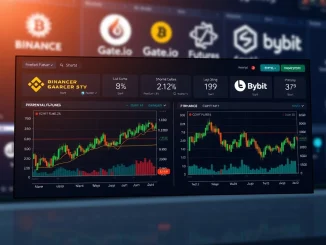
The cryptocurrency market is once again proving its unpredictable nature. Recent headlines scream about a significant dip in the Bitcoin price, which has seen a 2% drop from its recent peak of $120,000. This seemingly modest decline has triggered a cascade of over $517 million in crypto liquidations within a mere 24 hours, sending ripples of concern through the entire ecosystem. As the market tests the crucial $117,500 support level, investors and traders are grappling with heightened market volatility and a surge in speculative activity, particularly in altcoins. What’s truly happening under the surface, and how can you navigate these turbulent waters?
Understanding the Bitcoin Price Plunge and Massive Crypto Liquidations
Bitcoin, the leading cryptocurrency, recently experienced a sharp 2% decline, pushing its price down from a high of $120,000. This movement wasn’t just a minor fluctuation; it acted as a catalyst for widespread liquidations across the crypto market. Over $517 million in leveraged positions were wiped out in a single day, impacting hundreds of thousands of traders. This massive liquidation event highlights the inherent risks associated with highly leveraged trading in a volatile market.
Traders often refer to such events as a ‘strategic liquidity sweep.’ This occurs when aggressive sell-side pressure absorbs stop orders and leveraged positions, effectively ‘flushing out’ over-leveraged participants. The goal, from a market dynamics perspective, is often to stabilize price dynamics around critical support levels, such as the $117,500 mark Bitcoin is currently testing. This level is crucial, as its ability to hold could dictate Bitcoin’s short-term trajectory.
| Metric | Details |
|---|---|
| Bitcoin Price Drop | 2% from $120,000 peak |
| Total Liquidations (24h) | Over $517 million |
| Liquidated Traders (24h) | 176,000+ |
| Key Support Level Tested | $117,500 |
| Altcoin Open Interest (OI) | Record $40 billion |
Expert Insights: What’s Next for Bitcoin’s Support Levels?
Crypto analysts are weighing in on the current market dynamics, offering varied perspectives on where Bitcoin might head next. Michaël van de Poppe, a respected crypto analyst, views the recent price action as a consolidation within an established range, rather than a definitive breakout. He suggests that further downward tests of key support zones might be necessary before Bitcoin can resume its bullish momentum. This perspective implies that the market is still finding its footing and isn’t ready for a sustained upward trend just yet.
Adding to this technical analysis, trader Crypto Virtuos has pointed to critical Fibonacci retracement levels as crucial indicators. He forecasts a possible correction down to $113,000, identifying it as the 0.618 Fibonacci support level. Despite this potential short-term dip, Crypto Virtuos maintains a cautiously optimistic outlook for a rebound, suggesting a potential move towards $138,000 in the medium term. These technical insights provide a roadmap for traders looking to identify potential entry and exit points amidst the current volatility.
The Rising Tide of Altcoin Froth and Its Impact on Market Volatility
While Bitcoin navigates its own challenges, the broader crypto market is experiencing significant altcoin froth, amplifying overall market volatility. On-chain analytics firm Glassnode reports that Open Interest (OI) in major altcoins has soared to a record $40 billion. Open Interest represents the total number of outstanding derivative contracts that have not been settled, and a high OI typically signals heightened leverage and, consequently, more fragile market conditions.
Elevated OI levels, while sometimes indicative of strong bullish sentiment and increased participation, also significantly amplify downside risks. This creates an environment where sharp corrections can occur rapidly, as evidenced by the 176,000 traders who were liquidated in the last 24 hours. Glassnode’s analysis underscores the dual-edged nature of leveraged positions: they can drive rapid price swings in either direction, making the market susceptible to sudden and dramatic shifts.
Navigating Uncertainty: Essential Strategies for Bitcoin Investors
For both seasoned traders and new investors, the current interplay between Bitcoin’s liquidity dynamics and the speculative altcoin froth demands heightened caution. Understanding where Bitcoin support levels lie and how market sentiment is shifting is more critical than ever. Here are some actionable insights to consider:
- Prioritize Risk Management: Implement strict risk management protocols, including setting stop-loss orders to limit potential losses on leveraged positions. Avoid over-leveraging, especially during periods of high volatility.
- Diversify Portfolios: While Bitcoin remains a cornerstone, a diversified portfolio can help mitigate exposure to sudden price swings in any single asset.
- Monitor On-Chain Data: Tools like Glassnode provide invaluable real-time insights into market health, open interest, and liquidity flows. Staying informed with such data can provide an edge.
- Utilize Technical Analysis: Employ technical tools such as Fibonacci retracements, moving averages, and order book assessments to identify potential entry and exit points and understand critical support and resistance levels.
- Understand Liquidity Concentrations: The concentration of order book liquidity near $117,500 suggests a potential floor for near-term price consolidation. Monitoring these levels can help gauge the strength of price bounces or breakdowns.
The convergence of these factors—Bitcoin’s price testing crucial support, massive liquidations, and rampant altcoin speculation—underscores a market at a crossroads. While short-term corrections appear likely, the medium-term outlook for Bitcoin remains cautiously optimistic, contingent on the stabilization of leveraged positions and a reduction in speculative fervor. Investors are advised to prioritize risk management, including diversified portfolios and real-time monitoring of on-chain data, to mitigate exposure to sudden volatility.
Frequently Asked Questions (FAQs)
1. Why did Bitcoin’s price drop by 2% and what are crypto liquidations?
Bitcoin’s recent 2% price drop was part of broader market volatility, triggered by factors like profit-taking, shifts in market sentiment, and speculative activity. Crypto liquidations occur when a trader’s leveraged position is forcibly closed by an exchange due to insufficient margin to cover potential losses. The recent $517 million in liquidations indicate a large number of over-leveraged positions were wiped out as Bitcoin’s price moved against them.
2. What is the significance of the $117,500 support level for Bitcoin?
The $117,500 level is considered a critical Bitcoin support level because it represents a concentration of order book liquidity. This means there are many buy orders placed at or near this price, which could act as a floor, potentially halting further price declines and providing a base for consolidation or a rebound. Testing this level indicates market participants are evaluating its strength.
3. How does altcoin Open Interest (OI) affect the broader crypto market?
Open Interest (OI) in altcoins reaching a record $40 billion signals heightened leverage in the market. While high OI can indicate strong bullish momentum, it also makes the market more fragile and prone to sharp corrections. If prices move unfavorably, these highly leveraged positions can be quickly liquidated, leading to cascading sell-offs and increased market volatility, impacting Bitcoin and other assets.
4. What technical levels are analysts watching for Bitcoin’s price?
Analysts like Michaël van de Poppe are watching for further consolidation within established ranges, suggesting potential tests of lower support zones. Crypto Virtuos specifically points to the 0.618 Fibonacci retracement level at $113,000 as a key support, while maintaining an optimistic outlook for a rebound towards $138,000. These levels help traders anticipate potential price movements.
5. What strategies can investors use to manage risk during volatile periods?
During periods of high market volatility, investors should prioritize risk management. Key strategies include: avoiding excessive leverage, setting clear stop-loss orders, diversifying their portfolios across different assets, continuously monitoring on-chain data for real-time insights, and utilizing technical analysis tools like Fibonacci retracements and order book assessments to make informed decisions.



